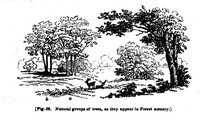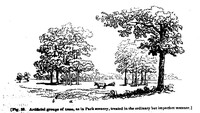The two sketches annexed [figs. 58 and 59] exemplify this remark; the first represents a few young trees protected by cradles, and though some of them appear nearer together than others, it arises from their being seen in perspective, for I suppose them to be planted (as they usually are) at nearly equal distances. In the same landscape I have supposed the same trees grown to a considerable size, but from their equi-distance, the stems are all parallel to each other, and not like the group below, where, being planted much nearer, the trees naturally recede from each other. A few low bushes or thorns produce the kind of group in the lower sketch, consisting of trees and bushes of various growth. It may be observed that the single tree, and every part of the upper sketch, is evidently artificial, and that the lower one is natural, and like the groups in a forest. Another source of variety may be produced by such opaque masses of spinous plants as protect themselves from cattle; thus stems of trees seen against lawn or water are comparatively dark, while those contrasted with a background of wood appear light. This difference is shewn in both these sketches: the stems of the trees a a appear light, and those at b b are dark, merely from the power of contrast, although both are exposed to the same degree of light.



